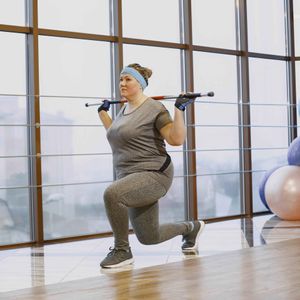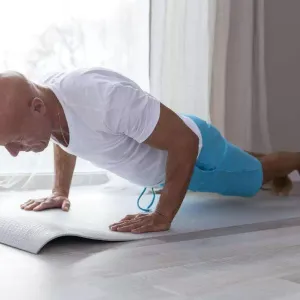

Our Review Process
Our articles undergo extensive medical review by board-certified practitioners to confirm that all factual inferences with respect to medical conditions, symptoms, treatments, and protocols are legitimate, canonical, and adhere to current guidelines and the latest discoveries. Read more.
Our Editorial Team
Shifa Fatima, MSc.
Author
Dr. Apoorva T, MHM.
MEDICAL ADVISOR
Warm Up And Its Importance
There’s no debating that the key to a healthy lifestyle is working out 4-5 times a week — whether it is going for a brisk walk, a run or even to the gym. However, there is one thing that is as important as the workout itself and is often overlooked, compromised on or worse completely skipped – the warm up!
Table of Contents
What is a Warm-up?
A warm-up is a primary element in any workout session. It includes a set of low intensity movements and exercises one must do before jumping into the main workout routine. Ideally it’ll leave you with a light sweat and prep you for the main workout. A good warm-up helps to warm up your muscles which in turn lessens the chances of an injury during the actual workout. Not all warm-ups are created equal. There are different types of warm-ups – active and passive. Let’s focus on understanding Active Warm-ups, which is further divided into two types
- Non-Specific Movement Warm-Up : This type of warm-up has exercises that increase the heart rate such as jogging or cycling. These exercises are usually basic physical activities that most people can do.
- Specific Movement Warm-Up : This warm-up includes activities and stretches that are specific to the workout that will be done after the warm-up. Like if you’re preparing for a brisk walk, then the warm-up could include slower-paced walking.What's the Fuss about Warm-ups? Also know about yoga for diabetes type 1
Why is a Warm-Up Important?
There’s no debating that the key to a healthy lifestyle is working out 4-5 times a week — whether it is going for a brisk walk, a run or even to the gym. However, there is one thing that is as important as the workout itself and is often overlooked, compromised on or worse completely skipped – the warm up!
Reduce your risk of injury: This is a highly overlooked reason for warmups. Not only does a warm-up activity prepare your muscles for what is about to come but it also significantly reduces the risk of injury, pulls, cramps, etc. Any exercise that essentially results in the warming up of the body would improve the elasticity of the muscles. Additionally, it will also result in efficient cooling which reduces the chances of hurting yourself or even overheating the muscles during the workout. Avoid any injuries by warming up well before going to the gym or engaging in any form of exercise.
Well, it’s not so much about breaking a sweat as it is about prepping your body for what’s coming next – your workout. A good warm-up routine prepares the body physically and mentally for the upcoming workout. It helps in improving the muscle dynamics so that you are less prone to injury and prepares you for the upcoming workout routine. A warm-up leads to
- Faster movements in your workout
- Better flexibility
- Improved stability
- When done properly, everything else flows better and no ripped hamstrings or ankle sprains
What are the Benefits of doing a Warm-up?
- Increases Blood Flow : Blood carries the oxygen needed for your muscles to function. Hence and increased blood flow is one of the best things you can do to set your muscles up for your workout.
- Activates the Nervous System : While performing any exercise, the body works in harmony with the skeletal and muscular system and also the nervous system. Activating the central nervous system will help recruit more muscle fibers and allow you to perform your workout with more power and thus increase efficiency and quality of your workout
- Increases Mind-Muscle coordination through related movements : Warming up with related movements mentally prepares the body for the main workout and the brain becomes focused on the way the body is performing during this process. This kind of coordination and focus will help you do your workout with better technique & coordination and thus improve overall performance.

What are the Key Components of a Warm-up?
Now that you have understood the importance of a warm-up, here are the Key Components of a good warm-up routine
- Heart Rate Elevator : It has an aerobic element that is low on intensity but works on the cardiovascular system to gradually increase the heart rate. Your heart rate should not rise too quickly. Going from 50 to 100 would be like leaping out of bed in the morning without sitting up or stretching. By steadily raising your heart rate, it reduces the stress on the heart. Good heart rate elevator movements include spot jogging, jumping jacks, foot fires and more.
- Mobilizer : Mobility drills focus on the joint and muscles simultaneously and increase the range of motion and elasticity respectively. This works on increasing the capacity of movement in a joint which decreases the risk of injury, increases performance and efficiency. Mobilizer movements include the cat and camel, dynamic frog stretch, world’s greatest stretch and more.
- Dynamic Stretching : Dynamic stretching gets the body primed for activity. It helps to increase strength and speed of contraction of muscles for exercises like jump squats, lunge twist, knee to chest and more.
- Multi-dimension / Multi-planar Movements : During an exercise regime, the body needs to move in multiple directions and with a full range of motion. The joints and muscles around it aid in doing so.
- Activating Muscle Groups : Muscle activation is an essential part of warm-ups. It triggers and strengthens muscle fibers. You must activate the muscles that are going to be worked while performing the workout. The ability of muscles to contract increases by doing so and thus increasing the performance. For instance, on the day you’re going to do deadlifts, good mornings are a great option to perfect the hinge pattern.
How Long Should a Warm-up Last?
Every warm-up is different as there are various ways, various intensities for every body type. A greater level of intensity in the warm-up will cause a greater increase in muscle temperature. Ideally, a warm-up should be kept between 3 to 10 minutes depending on the duration and kind of exercise which is to be done. Studies show that an intensity above 60% of a person’s maximal oxygen uptake (V-O2 Max) is seen to reduce the concentration of available energy phosphates. Hence it is recommended that the intensity should be kept between 40-60% of a person’s V-O2 Max. If appropriate instruments are not available to measure the V-O2, it can be identified when you see light to mild sweating, without fatigue under normal circumstances. But dont stress, the perfect warm-up will come with practice, experimentation and experience.
Warm-up Exercises for You
Now that the importance of warm-up exercise has been determined, the next step would be to list down certain workouts that can be constituted as good and efficient warm-ups. 5-10 minutes of these exercises before you begin your full-fledged routine of strenuous workouts would be vital for the appropriate heating of the muscles and core temperature of the body. Ensure that your list contains exercises that will work on and heat the different muscle groups in the body. No static stretches should be included in these exercises as they are often a part of the cool-down process. Here are some exercises that you could conduct as a part of your warm-ups:
- Spot March – Time: 3-4 minutes – Stand erect in a marching stance and begin by raising your legs (almost at a 90-degree angle at the knees). Move your arms as you move your legs in a rhythmic motion.
- Heel digs – Time: 1-2 minutes – Stand straight with your arms held outwards parallel to the ground. Place alternate heels out in the front and keep the toes pointing up as you punch out with each heel dig.
- Alternate knee-touch – Time: 1-2 minutes – Bend your legs as you bring your knees up 90-degrees and touch your knees with the alternate hands. Ensure that your core is tight and your back is straight.
- Shoulder rolls – Time: 1 minute – Keep marching on the spot as you roll your shoulders forwards and backward with your arms hanging loose on the side.
- Jumping jacks, spot jogging, lunges, squats, ankle rotation, etc are also good exercises such as warm-ups.
Warm-up Routines : Beginner vs Advanced
Ideally a warm-up should be tailored to meet the individual’s demands. It needs to increase your muscle temperature but at the same time should not have a significant decrease in high-energy phosphate availability. The key components in a warm-up for people of different levels would be the same. However, the intensity should ideally vary between someone who is just starting their fitness journey as compared to someone active and regular with workout regimes.
How do you know you’re Warmed up enough?
An effective warm-up routine should not be intense or grueling. It should adequately warm up all your muscles and you should ideally break into a light sweat. This is because a light sweat indicates that the body’s cooling system has been activated which subsequently ensures that the working tissues are warm and prepared for the workout. The focus should be on preparing your central nervous system, primary movers and pushing your core temperature.
Do's and Don'ts of a Warm up
Do’s
- You should majorly focus on the muscles that are going to be activated during the workout. For example, high marches can be done as a warm-up before a workout that needs sprinting.
- Your warm-up should consist of key components like increasing the body’s core temperature or movements to be done that are specific to the exercise.
- You should add movements to increase neuromuscular activation. This can be done by adding balance and postural stability exercise in the warm-up like standing single-leg scapular activation, glute bridge, supine torso rotation and more.
- Ensure core activation in the warm-up routine.
Don’ts
- Don't Skip the Warm-up
- Do not exhaust yourself while warming up.
- Don’t spend too much time.
- Do not perform non-targeted or non-specific movements.
Bottom Line
While we understand that work and other commitments can leave you running short on time, tempting you to skip the warm-up, these few minutes of the warm-up will make your workout more effective. By warming up your muscles, you are priming them to do their job more efficiently and it also lowers the risk of getting injured while performing the main exercise. So the next time you decide to skip the warm-up, think again as these 5-10 minutes are worth the effort.
FAQs
1. Should we warm up before Yoga?
Yes, since yoga is also a form of exercise, it is important to warm up before beginning yoga as the muscles might be cold and stiff. This could lead to an injury.
2. Is walking a form of warm up?
Yes, walking can be considered a good form of warm-up, especially in the beginning. Slowly, you can push to jogging, butt kicks, high knees, arm rotations while walking, etc.
3. What is the best exercise for people with Diabetes?
People with diabetes can actually engage in any kind of exercise they want as long as they keep their blood sugar level in check. However, a few helpful forms of exercise would be – walking, cycling, swimming, aerobics, yoga, jogging, occasional strength training, etc.
4. What is the best Yoga for people with Diabetes?
Experts have suggested several Yoga for people with diabetes that are meant to be helpful and create a positive impact on the oxygenation of the body, relief of stress, and stimulation of the pancreas. Some of these asanas are – the child pose, bow pose, corpse pose, mountain pose, etc.
References
- https://exerciseright.com.au/warm-ups-training-important/
Disclaimer
This website's content is provided only for educational reasons and is not meant to be a replacement for professional medical advice. Due to individual differences, the reader should contact their physician to decide whether the material is applicable to their case.








